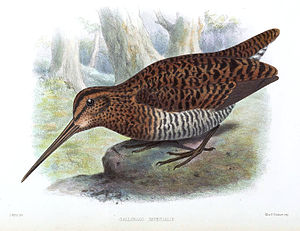Imperial Treasury
| Imperial Treasury | ||||||||||
|---|---|---|---|---|---|---|---|---|---|---|

Kaiserbekassine ( Gallinago imperialis ), |
||||||||||
| Systematics | ||||||||||
|
||||||||||
| Scientific name | ||||||||||
| Gallinago imperialis | ||||||||||
| Sclater & Salvin , 1869 |
The imperial cassin ( Gallinago imperialis ) is a medium-sized, long-beaked species from the family of snipe birds (Scolopacidae). Their occurrence is limited to cloud forests near the tree line in the northern Andes . For a long time only one other specimen was known from Colombia besides the type specimen and the species was thought to be extinct. It was only rediscovered in 1972 near Vilcabamba in Peru and has since been found in other parts of the northern Andes in Colombia and Ecuador . The Kaiserbekassine is very rare due to its habitat requirements, but where it occurs it is noticeable with its loud courtship flights.
description
With a body length of 29–31 cm, the Kaiserbekassine is roughly between the double -cock and the woodcock . The 87–94 mm long beak is dark gray-brown with a strong, high base and slightly bent tip. The iris is brown. When the wing is folded, the wings are completely covered by the shield springs . The wing length is between 161 and 162 mm, the tail length at 58 mm. The legs and feet are medium gray and feathered up to the intertarsal joint. The sexes are probably no different. The youth dress has not yet been described and nothing is known about a geographical variation.
The Imperial Treasury is predominantly colored dark brown. While the typical striped pattern is indicated on the head, it is missing on the back. On the otherwise dark brown crown there is a dark maroon central stripe. The rest of the head and the upper side are dark chestnut colored and banded with black spots. The beard stripe is colored medium brown. The color of the upper side continues on the throat and chest, but is more mottled than banded. The lower belly is banded dark brown on a whitish background. The under tail-coverts are blackish with some fine, white tips. The gray-brown tail, which consists of 12 control feathers, is unpatterned. The outer control springs are about 8 mm wide.
Vocalizations
The Kaiserbekassine is noticeable at dawn and dusk due to its loud courtship flights high above the forest. The singing to be heard (audio sample) consists of ten seconds of rows of hoarse sounds repeated with an interval of about six seconds, the volume of which increases and decreases again. At the end of the stanza the bird glides down a little and pulls up again with a whirring noise, which is probably produced by the outer control springs.
Way of life
The habitats of the Kaiserbekassine are over 3000 m above sea level in the area of the tree line in moist mountain forest. The settlement density is apparently only very low. Nothing is known about the way of life. The courtship flights were recorded in July and August.
literature
- Peter Hayman , John Marchant, Tony Prater: Shorebirds: An identification guide. , Houghton Mifflin Company , Boston 1986, ISBN 0-395-37903-2 .
- John Terborgh, John S. Weske: Rediscovery of the Imperial Snipe in Peru , The Auk No. 89/3, 1972, pp. 497-505, ( PDF ).
Remarks
- ↑ Hayman et al. (1986) state "tertials" (umbrella springs) here, while the original source Terborgh / Weske (1972) cited there speaks of "secondaries" (arm swinging). Whether it is a contradiction, an error or a correction by Hayman et al. is not exactly understandable.
- ↑ Hayman et al. (1986) speak of “barred” here, while the original source Terborgh / Weske (1972) cited there uses the term “mottled”.
Web links
- Gallinago imperialis in the endangered Red List species the IUCN 2012. Posted by: BirdLife International, 2009. Accessed October 17, 2012th
- xeno-canto: sound recordings - Imperial Snipe ( Gallinago imperialis )
- Imperial Snipe at World Land Trust , documentation page with photo, accessed on October 19, 2012.
- Videos, photos and sound recordings on Gallinago imperialis in the Internet Bird Collection
Individual evidence
- ↑ Nick Athanas: XC6653 · Kaiserbekassine · Gallinago imperialis . xeno-canto.org. January 7, 2001. Retrieved June 1, 2019.